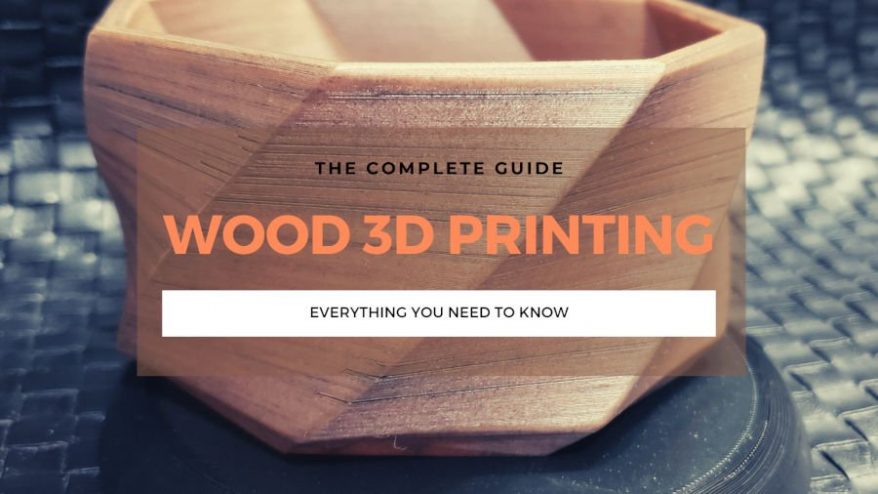
Wood 3D printer filaments create beautiful wood-like parts with ease on even the most basic, affordable 3D printers. They make great display objects that show off their wood aesthetics, and can be controlled for the wood tone and darkness you want.
Rather than 3D printing whole wood, these wood filaments are typically 70% PLA filament mixes with around 30% wood derivatives – typically from sawdust or other fibers.
- We also have an in-depth guide on 3D printing PLA filament.
- You can also view our complete guide to every 3D printer filament.
The majority PLA component makes the filament far easier to print than other composite, abrasive filaments like carbon fiber, with similar printing properties to standard PLA – though there are some nuances to be aware of.
Post-processing offers numerous color and finishing options and can be easily manipulated to your liking – wood is a very versatile filament overall. However, don’t get carried away thinking you’ll be able to print wood parts identical to the real thing – though they have a wood appearance, closer inspection will reveal the truth.
History of wood filaments in 3D printing
Wood filaments as we know them first appeared as hobbyist experiments between 2011-2012 before becoming more widely adopted. However, Wood-Plastic Composites (WPCs) have existed since the 1990s. These composite WPCs mix thermoplastics like PLA or PP with wood, but with a different extrusion technique to 3D printing.
Thingiverse member Kaipa published one of the earliest wood 3D printing projects, uploading a selection of wood 3D printed parts he designed back in September 2012. Though the filament’s secret recipe was not revealed, Kaipa offered to send filament spools to any interested parties.
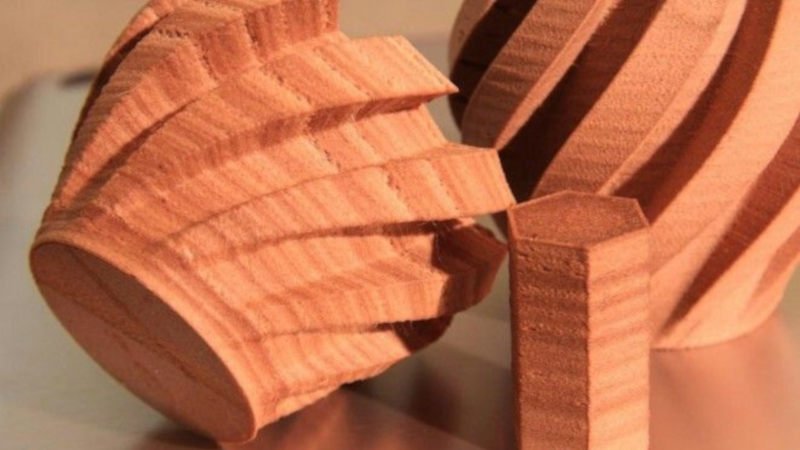
The filament, named Laywoo D-3, was far more easily paintable than standard PLA or ABS filaments, and changed color based on the 3D printer’s temperature. Jeremie Francois, a French maker, further experimented and developed specialized software for 3D printing wood.
Fast forward to the present day and wood 3D printing has become far more prevalent for hobbyists and makers worldwide. While unlikely to be used for much in industry, the material offers wood-like aesthetics for a variety of fun projects.
- Want more specialty filaments? Check out our guide for marble 3D printer filament.
- You can also check out our guide to the best glow in the dark PLA.
Properties of wood filament
Wood filaments typically contain around 70% PLA and 30% wood elements. This ratio can vary – some may be 60% PLA and 40% wood – but does not swing wildly beyond this.
Despite comprising just 30% wood, 3D printed parts do feel wooden and require careful study to spot inconsistencies that hint at their true PLA base.
As the material is mostly PLA, filaments can be brittle and snap or break under moderate pressure. Some wood filaments are claimed to be less brittle than PLA, whereas some appear to be even more delicate.
A variety of different wood filaments are available, including bamboo, pine, coconut, cork, cedar, birch, and more. Some wood filaments are not made with authentic wood fibers however, and do not offer the same wood-like finish or smell – so check before you buy. These filaments also do not stain as well as those with real wood elements.
Wood 3D Printing Tips
What extruder temperature should you 3D print wood at?
As wood 3D printer filaments feature mostly PLA, these filaments print at similar extruder temperatures of between 170-220C (or up to 240C for a much darker wooden finish). Your preferred wood finish will affect your chosen wood 3D printing temperature.
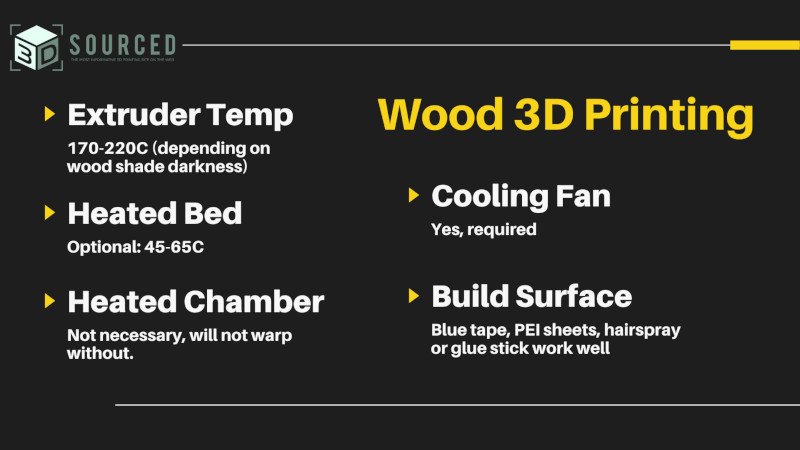
This is because the higher the temperature you print your wood filament at, the darker the wood will be stained – so if you want a darker finish, turn printing temperature up to further stain the wood fibers, but if you want a lighter wood 3D print, print at the lower end.
However, remember that just as with real wood, these filaments are flammable and can catch fire.
As with standard PLA, wood filaments can tend to ooze and string. This can be mitigated in your 3D slicer settings to optimize retraction and avoid your nozzle traveling outside the 3D printer model.
Moreover, smaller nozzles are not recommended for wood 3D printing. The wood fibers can clog even 0.4mm nozzles, so it’s recommended to switch out for a 0.5mm nozzle or larger. Always try to clean your 3D printer nozzle after printing to remove residue. Feeding a small amount of PLA through will sort this.
The wood aesthetic also hides layer lines effectively, so do not fear using larger layer heights than you are accustomed to. Slightly larger layer sizes will not affect your part’s finish.
Do you need to use a heated bed and enclosure to 3D print wood?
As with PLA, a heated bed is not strictly required to 3D print wood filaments, but is always good for improving results. A heated bed temperature of anywhere between 45-65C will almost always both prevent any small amount of warping, and leave you with high quality 3D prints.
You will need to use a cooling fan, just as with PLA. An enclosure however is not required, so any open area 3D printers, such as 3D printer kits like the Ender 3, CR-10 or other lower cost 3D printers should have no issue with wood filaments.
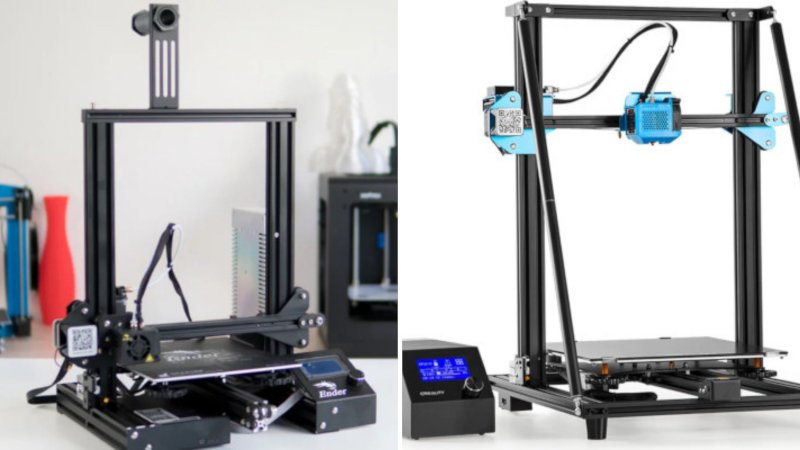
Best build surfaces for wood 3D printing
Wood 3D printer filaments are easier to print with than other composite filaments like NylonX or carbon fiber filaments.
Standard build surfaces such as blue tape, glue stick or hairspray, or PEI sheets help keep parts from moving, and improve adhesion. A glass plate can also help with adhesion.
Wood part post-processing
Wood 3D printing filaments offer very wide post-processing options. For any smoothing, wood parts can be easily sanded for a better finish – far easier than standard PLA prints.
You can also apply a stain to further finish and darken your wood prints and bring out the grainy aesthetic. Some makers have reported that gel stains work especially well on 3D printed wood PLA.
Wood parts also work similarly to PLA in that parts can be superglued together, for example if you’re creating a larger wood 3D printing project and need to print multiple parts. Make sure however that any joining method you use does not involve heat, as this can affect prints.
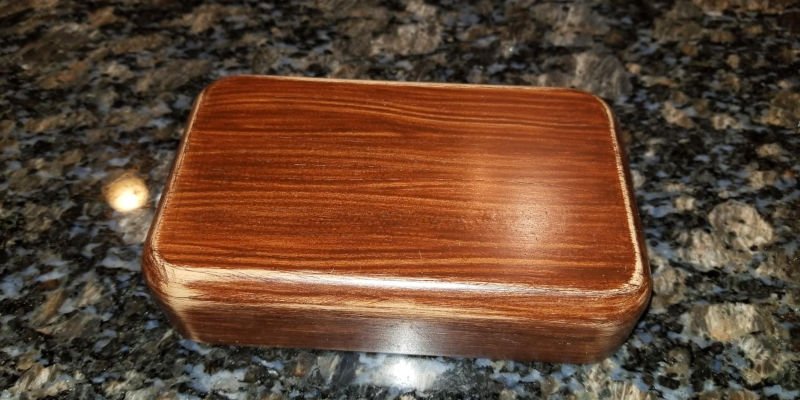
If you have a laser engraver or DIY CNC router you can even create custom features or brand your prints afterwards.
How much do wood filaments cost?
The very cheapest wood-filled filaments start at around $30, but are often made to look like wood rather than using wood fibers. High quality wood filaments can often cost $50 or more, sometimes reaching the $70 mark.
Best wood filaments
Here are some wood filament brands and resellers we recommend:
- Lowest cost filaments available starting at $30 here on Amazon
- Medium-price wood filaments available on Matterhackers here
- High quality wood filament range on Dynamism here
Best wood 3D printers
Additionally, as a fairly easy to print filament, even lower cost printers can print wood without much issue. We recommend some of the following 3D printers for printing wood:
| Name | Build Volume (mm) | Price | Best price available at: | Alternative purchase option |
|---|---|---|---|---|
| Creality Ender 3 V2 | 220 x 220 x 250 | $279 | Amazon here | 3DJake UK & Europe |
| Creality Ender 5 Pro | 220 x 220 x 300 | $399 | Amazon here | 3DJake UK & Europe |
| Monoprice Voxel | 150 x 150 x 150 | $449 | Amazon here | |
| Creality CR-10 V3 | 300 x 300 x 400 | $529 | Amazon here | 3DJake UK & Europe |
| Qidi Tech X-Pro | 230 x 150 x 150 | $469 | Amazon here | 3DJake UK & Europe |
Pros and Cons of Wood 3D Printing
Advantages of wood filament
- Looks great: wood’s smooth finish can be surprisingly well mimicked in PLA wood filament mixes, creating stunning wood parts with ease. You can control for your chosen aesthetic based on how high you heat the filament, giving you control over your final part’s look.
- Authentic wood smell: wood filaments with real wood fibers smell fantastic, both during printing and when finished. Wood filaments are fantastic for a soothing birch or pine smell in your room.
- Easy to print for a composite filament: other filaments, especially abrasive filaments like carbon fiber- and glass-infused filaments, are tough to print and make mincemeat out of standard nozzles. However, wood filaments can be printed without specialized hardened steel nozzles and do not wreck your nozzle.
- Less brittle: as great as PLA is, both environmentally and in performance for the price, a major setback is its brittleness. However, with a 30% wood mix, some filaments can become slightly more durable and less susceptible to breaking and snapping under pressure – though this is not always the case.
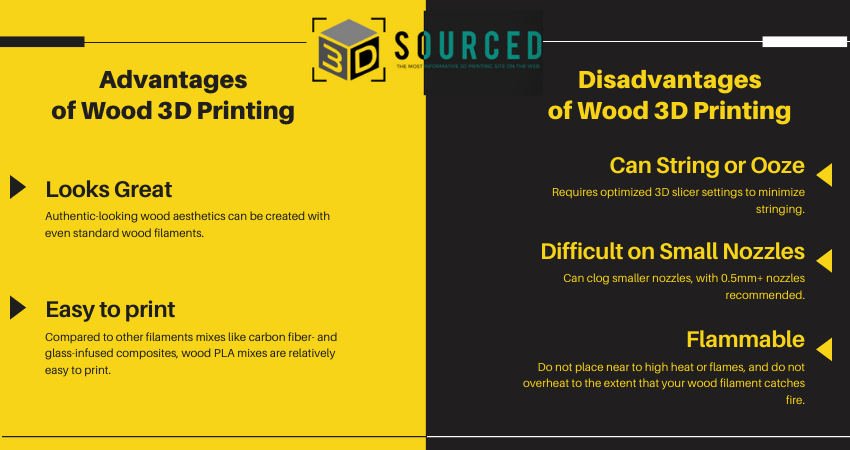
Disadvantages of wood filament
- Can string or ooze: like PLA, wood 3D printer filaments are prone to stringing and oozing. This can be minimized with the correct settings.
- Difficult on small nozzles: wood filaments can cause clogs during printing, especially on smaller nozzles. Larger nozzles give up some precision, but with wood’s finish this is not noticeable.
- Flammable: wood is obviously flammable, so too much heat and you risk lighting your model and 3D printer on fire. Stay within the recommend printing temperatures and keep your filament away from fire hazards.
Storing wood filaments
It is always recommended to store filaments in a cool, dry place protected from the air and atmosphere. This is because nearly all filaments are hygroscopic and will absorb moisture from the air, ruining print quality.
PLA is hygroscopic, though not as badly as filaments like Nylon or Polycarbonate. Filament left out for a day or two will not noticeably deteriorate, though longer times can ruin prints. If your filament has been left out a while, you can still remove most of the moisture by drying your filament such as through a filament dryer.
We recommend keeping your filament in airtight filament containers, and dry them in the event of leaving them out too long, which we link to below:
- 5 PrintDry vacuum sealed filament storage containers — Available on Matterhackers here
- We recommend the PrintDry PRO filament dryer — Available on Matterhackers here
Wood 3D printing applications
Wood filaments are often used by makers to print fun household decorations and appliances.
More intricate wood pieces are made as 3D printed jewelry pieces, as well as a variety of 3D printed toy wooden projects, sculptures, art projects and more.
Some makers use wood-filled filaments to create fun decorations for their model train sets, while others make jewelry boxes and cases.
Its 3D printing properties make it less useful for manufacturing and industrial 3D printing, but its wonderful aesthetic maintains its popularity in hobbyist projects.
Credit for cover photo image: u/BrutalBooGz on Reddit




